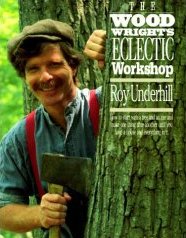

| Publisher | UNC Press |
| Year | 1991 |
| ISBN | 0-8078-4347-4 |
| Pages | 234 plus index |
Ken Greenberg
Let me start out by saying that any of Roy Underhill's books is worth reading. This one is a bit different from the others, and might be a bit "eclectic" as the title suggests. The obvious difference between this and the others is that instead of many short, project-oriented chapters, this book attempts to examine subjects in a bit more depth. It is divided into only six chapters. Each covers a number of related ideas. There's more of a flavor of "these are important things for people to know" than specific instructions on how to make things in this book. Just because it is different does not mean it is worse, but I get the feeling the author might have been feeling it was time to try a different approach.
1) Log Cabins. The title is pretty self-explanatory, and this section includes everything from felling trees to building a roof, with a bit of axe making and woodlot management thrown in.
2) Building On. This section covers a number of marginally related topics. There is a section on making planes, but it doesn't really tell you enough to make a good one in my opinion. There's also a description on making a fairly large loom and a collapsing ladder. Non-project discussions include how bricks were made, how a man on a Caribbean island bought a house as a kit, and so on.
3) Machines. This section covers a number of occupations, from wheelwright to millwright to cooper to gunsmith. Lots of little sections on how things were done, but not much on how to actually make anything here.
4) Furniture. There are some projects in this section, my favorite being the tavern table. This is just a low table with turned legs - interestingly, the detailed sketch shows the height of all elements but never addresses the length and width of the table. Perhaps it doesn't matter and you just make it fit the space available, but in the interest of appropriate scale it might be nice to know how big the one in the pictures is. There's also a "chair/table," a combination of a chest, a chair, and a tilting top. There is some discussion about the difference between making furniture for a city marketplace and making similar pieces for a country marketplace.
5) Amusements. This chapter covers everything from primitive toys (a Jacob's Ladder) to a wood and canvas kayak. He also spends some time talking about Ishi, the last "wild" Native American who came walking out of the woods in the Bay Area one day in 1911.
6) Musical Instruments. The emphasis here is on woodwinds (recorder, walking-stick flute, etc.) plus a simple Appalachian Dulcimer. Some nice charts are included to specify the spacing of frets in the dulcimer and the spacing of finger holes in the woodwinds. The instructions for building the various instruments vary some in detail, and for the most part the wind instruments assume you have a lathe.
All in all an entertaining read, but I didn't feel like rushing out to the shop to build any of the projects. Perhaps I'm just a bit beyond the somewhat primitive character of Roy's work here, and have become too much of a "city woodworker" by now. Still, your Roy Underhill collection isn't complete without this book, and your deck could probably use a tavern table or two to set your drink down on at the end of a long day in the shop.